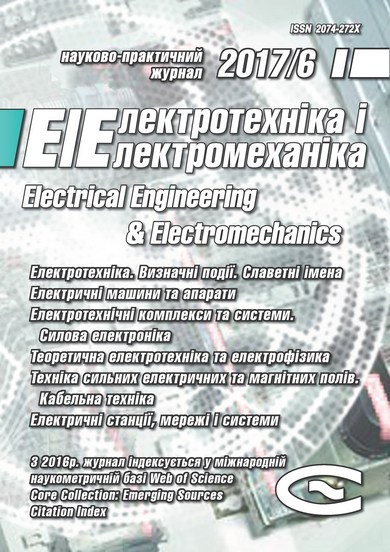IMITATION MODEL OF A HIGH-SPEED INDUCTION MOTOR WITH FREQUENCY CONTROL
DOI:
https://doi.org/10.20998/2074-272X.2017.6.02Keywords:
induction motor, squirrel cage, high-speed, scalar control, ANSYS, RMxprt, Simplorer, high-performance computing, simulation, vibration, noiseAbstract
Purpose. To develop the imitation model of the frequency converter controlled high-speed induction motor with a squirrel-cage rotor in order to determine reasons causes electric motor vibrations and noises in starting modes. Methodology. We have applied the mathematical simulation of electromagnetic field in transient mode and imported obtained field model as an independent object in frequency converter circuit. We have correlated the simulated result with the experimental data obtained by means of the PID regulator factors. Results. We have made the simulation model of the high-speed induction motor with a squirrel-cage rotor speed control in AnsysRMxprt, Ansys Maxwell and Ansys Simplorer, approximated to their physical prototype. We have made models modifications allows to provide high-performance computing (HPC) in dedicated server and computer cluster to reduce the simulation time. We have obtained motor characteristics in starting and rated modes. This allows to make recommendations on determination of high-speed electric motor optimal deign, having minimum indexes of vibrations and noises. Originality. For the first time, we have carried out the integrated research of induction motor using simultaneously simulation models both in Ansys Maxwell (2D field model) and in Ansys Simplorer (transient circuit model) with the control low realization for the motor soft start. For the first time the correlation between stator and rotor slots, allows to obtain minimal vibrations and noises, was defined. Practical value. We have tested manufactured high-speed motor based on the performed calculation. The experimental studies have confirmed the adequacy of the model, which allows designing such motors for new high-speed construction, and upgrade the existing ones.References
1. Ansys Maxwell 2D v.15 – Electromagnetic and Electromechanical Analysis: users guide. Ansys, Inc., Pittsburgh, release 15.0, 2012. 628 p.
2. Ansys Maxwell 3D v.15 – Electromagnetic and Electromechanical Analysis: users guide. Ansys, Inc., Pittsburgh, release 15.0, 2012. 1006 p.
3. Electric machines considering power electronics. Ansys, Inc., Pittsburgh, 2012, 58 p.
4. The design of electric machines using Maxwell and Simplorer. Ansys, Inc., 2013. 48 p.
5. Zhao X., Liu H., Zhang J., Zhang H. Simulation of field oriented control in induction motor drive system. TELKOMNIKA Indonesian Journal of Electrical Engineering, 2013, vol.11, no.12, pp. 7555-7563. doi: 10.11591/telkomnika.v11i12.3674.
6. Behera P.K., Behera M.K., Sahoo A.K. Speed control of induction motor using scalar control technique. International Journal of Computer Applications, 2014, no.1, pp. 37-39.
7. Apostoaia C.M. Co-simulation platform for AC drives control systems. Proc. WASET International Conference on Electric Machines and Drive Systems (ICEMDS ’2012), Paris, France, Nov. 2012, pp. 1879-1886.
8. Ramesh K., Kumar C.R., Murali P.B. Modeling and implementation of vector control for induction motor drive. International Journal of Computer Applications, 2015, vol.3, no.2, pp. 80-91.
9. 32-BIT Microcontroller 3-Phase ACIM Scalar Control Application Note. Spansion, Inc., revision 1.0, 2015. 22 p.
10. Scalar (V/f) Control of 3-Phase Induction Motors. Texas Instruments, Inc., sPRABQ8, 2013. 25 p.
11. Zelenov A.B. Teorijaj elektroprivoda [Electric drive theory]. Alchevsk, 2005. 508 p. (Rus).
12. Zablodskii N.N., Pliugin V.E., Petrenko A.N. Using of object-oriented design principles in electric machines development. Electrical Engineering & Electromechanics, 2016, no.1, pp. 17-20. doi: 10.20998/2074-272X.2016.1.03.
13. Zablodskij N., Pliugin V., Fligl S., Lettl J. Dynamic simulation of the double-stator induction electromechanical converter with ferromagnetic rotor. 4th International Conference on Power Engineering, Energy and Electrical Drives, Istanbul, Turkey, May 2013, pp. 1448-1453. doi: 10.1109/powereng.2013.6635828.
14. Zablodskii N.N., Plyugin V.E., Gritsyuk V.Y., Grin’ G.M. Polyfunctional electromechanical energy transformers for technological purposes. Russian Electrical Engineering, 2016, vol.87, no.3, pp. 140-144. doi: 10.3103/s1068371216030123.
15. Zablodskiy N., Pliugin V. 3D magnetic filed distribution in a screw double-stator induction motor. 2015 16th International Conference on Computational Problems of Electrical Engineering (CPEE), Lviv, Ukraine, Sep. 2015, pp. 239-241. doi: 10.1109/cpee.2015.7333386.
Downloads
Published
How to Cite
Issue
Section
License
Copyright (c) 2017 V. E. Pliugin, A. N. Petrenko, V. Grinina, O. Grinin, A. Yehorov

This work is licensed under a Creative Commons Attribution-NonCommercial 4.0 International License.
Authors who publish with this journal agree to the following terms:
1. Authors retain copyright and grant the journal right of first publication with the work simultaneously licensed under a Creative Commons Attribution License that allows others to share the work with an acknowledgement of the work's authorship and initial publication in this journal.
2. Authors are able to enter into separate, additional contractual arrangements for the non-exclusive distribution of the journal's published version of the work (e.g., post it to an institutional repository or publish it in a book), with an acknowledgement of its initial publication in this journal.
3. Authors are permitted and encouraged to post their work online (e.g., in institutional repositories or on their website) prior to and during the submission process, as it can lead to productive exchanges, as well as earlier and greater citation of published work.





